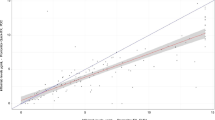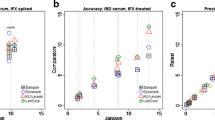Abstract
Objective
The primary objective is to assess whether the POC assays to measure infliximab residual trough level in the serum of IBD patients were non-inferior to the ELISA techniques available on the market, and to determine which of them was the most robust. The second is to compare three different ELISA kits for monitoring anti-infliximab antibodies (ATI).
Methods
The assays were carried out on patients’ sera using four ELISA kits from four different suppliers (three with a monoclonal antibody and one polyclonal) and two rapid techniques provided by BÜHLMANN (Quantum Blue®) and R-Biopharm (Ridaquick) for monitoring infliximab levels. ATI were measured by three ELISA sets (Grifols, Theradiag, and R-Biopharm) which have different positivity limits and different units.
Results
We measured infliximab residual level and ATI in the serum of 90 IBD patients (85 treated with infliximab and five with adalimumab). All of the infliximab assays were very well correlated when analyzed with Spearman nonparametric correlation (0.93 ≤ r ≤ 0.99), and the two POC assays were also excellently correlated (r = 0.98). The ATI monitoring kits revealed a correlation ranging from 0.73 to 0.96 when comparing positive and negative patients. When normalizing the quantitative values between the different ELISA tests (expressed arbitrarily by using multiples of the positivity limits defined by each supplier), the Spearman r coefficient ranged from 0.81 to 0.93.
Conclusion
The available evidence allows us to conclude that all of the infliximab monitoring assays correlate well and may be used for IFX monitoring; albeit variations in measured IFX concentration among different assays remain present, these assays could be interchangeable. The ATI monitoring techniques are all capable of detecting ATI-positive patients, but because of the difference in the positivity limits and the measurement units, it is better to follow a patient rate with one definite kit.


Similar content being viewed by others
References
Monaco C, Nanchahal J, Taylor P, Feldmann M. Anti-TNF therapy: past, present and future. Int Immunol. 2015;27:55–62.
Karampetsou MP, Liossis S-NC, Sfikakis PP. TNF- antagonists beyond approved indications: stories of success and prospects for the future. QJM. 2010;103:917–928.
Steenholdt C, et al. Individualised therapy is more cost-effective than dose intensification in patients with Crohn’s disease who lose response to anti-TNF treatment: a randomised, controlled trial. Gut. 2014;63:919–927.
Krieckaert CLM, et al. Personalised treatment using serum drug levels of adalimumab in patients with rheumatoid arthritis: an evaluation of costs and effects. Ann Rheum Dis. 2015;74:361–368.
Steenholdt C, Bendtzen K, Brynskov J, Thomsen OØ, Ainsworth MA. Cut-off levels and diagnostic accuracy of infliximab trough levels and anti-infliximab antibodies in Crohn’s disease. Scand J Gastroenterol. 2011;46:310–318.
Roblin X, et al. Combination of C-reactive protein, infliximab trough levels, and stable but not transient antibodies to infliximab are associated with loss of response to infliximab in inflammatory bowel disease. J Crohn’s Colitis. 2015;9:525–531.
Ben-Horin S, Chowers Y. Tailoring anti-TNF therapy in IBD: drug levels and disease activity. Nat Rev Gastroenterol Hepatol. 2014;11:243–255.
Steenholdt C, et al. Changes in serum trough levels of infliximab during treatment intensification but not in anti-infliximab antibody detection are associated with clinical outcomes after therapeutic failure in Crohn’s disease. Journal of Crohn’s and Colitis. 2015;9:238–245.
Kelly OB, Donnell SO, Stempak JM, Steinhart AH, Silverberg MS. Therapeutic drug monitoring to guide infliximab dose adjustment is associated with better endoscopic outcomes than clinical decision making alone in active inflammatory bowel disease. Inflam Bowel Dis. 2017;23:1202–1209.
Paul S, et al. Therapeutic drug monitoring of infliximab and mucosal healing in inflammatory bowel disease: a prospective study. Inflamm Bowel Dis. 2013;19:2568–2576.
Amiot A, et al. Therapeutic drug monitoring is predictive of loss of response after de-escalation of infliximab therapy in patients with inflammatory bowel disease in clinical remission. Clin Res Hepatol Gastroenterol. 2016;40:90–98.
Moore C, Corbett G, Moss AC. Systematic review and meta-analysis: serum infliximab levels during maintenance therapy and outcomes in inflammatory bowel disease. J Crohn’s Colitis. 2016;10:619–625.
Papamichael K, et al. Improved long-term outcomes of patients with inflammatory bowel disease receiving proactive compared with reactive monitoring of serum concentrations of infliximab. Clin Gastroenterol Hepatol. 2017. https://doi.org/10.1016/j.cgh.2017.03.031.
Vande Casteele N, et al. Trough concentrations of infliximab guide dosing for patients with inflammatory bowel disease. Gastroenterology. 2015;148:1320.e3–1329.e3.
Freeman K, et al. Clinical effectiveness and cost-effectiveness of use of therapeutic monitoring of tumour necrosis factor alpha (TNF-α) inhibitors [LISA-TRACKER® enzyme-linked immunosorbent assay (ELISA) kits, TNF-α-Blocker ELISA kits and Grifols® ELISA kits] versus standard care in patients with Crohn’s disease: systematic reviews and economic modelling. Health Technol Assess. 2016;20:1–288.
Silva-Ferreira F, Afonso J, Pinto-Lopes P, Magro F. A systematic review on infliximab and adalimumab drug monitoring: levels, clinical outcomes and assays. Inflamm Bowel Dis. 2016;22:2289–2301.
Bader L, et al. Assays for infliximab drug levels and antibodies: a matter of scales and categories. Scand J Immunol. 2017. https://doi.org/10.1111/sji.12572.
Freeman K, et al. Test accuracy of drug and antibody assays for predicting response to antitumour necrosis factor treatment in Crohn’s disease: a systematic review and meta-analysis. BMJ Open. 2017;7:e014581.
Vande Casteele N, et al. Detection of infliximab levels and anti-infliximab antibodies: a comparison of three different assays. Aliment Pharmacol Ther. 2012;36:765–771.
Lee MW, et al. Comparison of infliximab drug measurement across three commercially available ELISA kits. Pathology. 2016;48:608–612.
Steenholdt C, et al. Comparison of techniques for monitoring infliximab and antibodies against infliximab in Crohnʼs disease. Ther Drug Monit. 2013;35:530–538.
Davidov Y, et al. Association of induction infliximab levels with clinical response in perianal Crohn’s disease. J Crohn’s and Colitis. 2016. https://doi.org/10.1093/ecco-jcc/jjw182.
Kobayashi T, et al. First trough level of infliximab at week 2 predicts future outcomes of induction therapy in ulcerative colitis—Results from a multicenter prospective randomized controlled trial and its post hoc analysis. J Gastroenterol. 2016;51:241–251.
Baert F, et al. Early trough levels and antibodies to infliximab predict safety and success of reinitiation of infliximab therapy. Clin Gastroenterol Hepatol. 2014;12:1474.e2–1481.e2.
Lu J, et al. Fiber optic-SPR platform for fast and sensitive infliximab detection in serum of inflammatory bowel disease patients. Biosens Bioelectron. 2016;79:173–179.
Vande Casteele N, et al. Letter: dry blood spots for anti-TNF treatment monitoring in IBD. Aliment Pharmacol Ther. 2013;37:1024–1025.
Lu J, et al. Immunoassay for detection of infliximab in whole blood using a fiber-optic surface plasmon resonance biosensor. Anal Chem. 2017;89:3664–3671.
Afonso J, et al. Proactive therapeutic drug monitoring of infliximab: a comparative study of a new point-of-care quantitative test with two established ELISA assays. Aliment Pharmacol Ther. 2016;44:684–692.
Bian S, et al. Development and validation of an optical biosensor for rapid monitoring of adalimumab in serum of patients with Crohn’s disease. Drug Test Anal. 2017. https://doi.org/10.1002/dta.2250.
Magro F, et al. Clinical performance of an infliximab rapid quantification assay. Ther Adv Gastroenterol. 2017;10:651–660.
Stappen V, et al. An optimized anti-infliximab bridging enzyme-linked immunosorbent assay for harmonization of anti-infliximab antibody titers in patients with inflammatory bowel diseases. IBD. 2015;9:2172–2177.
Gils A, et al. Harmonization of infliximab and anti-infliximab assays facilitates the comparison between originators and biosimilars in clinical samples. IBD. 2016;22:969–975.
Peng X, et al. Development and validation of LC–MS/MS method for the quantitation of infliximab in human serum. Chromatographia. 2015;78:521–531.
Jourdil J-F, et al. Infliximab quantitation in human plasma by liquid chromatography-tandem mass spectrometry: towards a standardization of the methods? Anal Bioanal Chem. 2017;409:1195–1205.
Author information
Authors and Affiliations
Corresponding author
Ethics declarations
Conflict of interest
The authors declare that they have no conflict of interest.
Electronic supplementary material
Below is the link to the electronic supplementary material.
Supplementary Figure 1
Distribution of IFX trough levels between assays in the different quartiles. For the quartile comparison, a one-side Cochrane–Armitage trend test has been used. (TIFF 77 kb)
Supplementary Figure 2
Bland–Altman plots of infliximab trough level comparing different techniques two by two. The difference between the two measurements (µg/mL) is plotted on the Y-axis and the average of the two measurements (µg/mL) on the X-axis. Dotted lines represent the 95% limits of agreement. Gap 1: IFX trough level < 3µg/mL, Gap 2: IFX trough level between 3 and 7µg/mL, Gap 3: IFX trough level >7µg/mL. T: Theradiag ELISA. RB: R-Biopharm ELISA. S:Sanquin ELISA. G:Grifols ELISA. RBP: R-Biopharm POC. BP: Buhlmann POC. (TIFF 236 kb)
Rights and permissions
About this article
Cite this article
Nasser, Y., Labetoulle, R., Harzallah, I. et al. Comparison of Point-of-Care and Classical Immunoassays for the Monitoring Infliximab and Antibodies Against Infliximab in IBD. Dig Dis Sci 63, 2714–2721 (2018). https://doi.org/10.1007/s10620-018-5144-y
Received:
Accepted:
Published:
Issue Date:
DOI: https://doi.org/10.1007/s10620-018-5144-y




